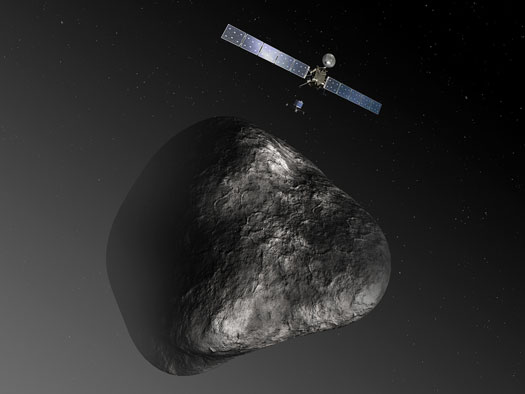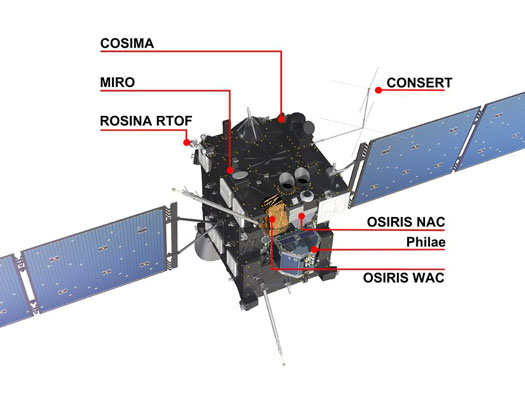| Jan 17, 2014 |
Rosetta's final sprint to the comet
|
|
(Nanowerk News) Deep in space, around 814 million kilometres from Earth, an alarm clock will ring next Monday: at 11 a.m. Central European Time a timer clock on board ESA’s Rosetta space probe will initiate a series of internal commands. The navigation instruments will be slowly warmed up and will start to take their orientation from the starry sky; the space probe, which has so far rotated about its own axis, will stabilise itself, point its main aerial towards Earth and radio a signal - for the first time after more than 30 months in hibernation - to Earth. Some time after 6:30 p.m. at the earliest, the ground station of the European Space Agency in Darmstadt is expected to receive the signal which will bring a sigh of relief: everything OK, Rosetta is awake.
|
|
The electronic wake-up call is much more than an unusual technical procedure from the world of space travel. Rather, it heralds the last stage of a journey through the solar system that has lasted more than 10 years. At its end is the unique encounter between the European space probe and the 67P/Churyumov-Gerasimenko comet, which the scientists call 67P for short, in August of this year.
|
|
In contrast to all earlier missions, where the probes hurtled past the particular comet at high velocity, this encounter will be everything but fleeting. At least until the end of December 2015, Rosetta will orbit “its” comet, accompany it on its journey towards the Sun and investigate it at close range with the aid of its eleven scientific board instruments.
|
 |
|
Rendezvous in space: The meeting between Rosetta and the 67P/Churyumov/Gerasimenko comet will be anything but fleeting: The plan is for the probe to accompany the comet until at least the end of 2015. In November of this year the Philae lander will touch down on its surface. (Image: ESA – C. Carreau/ATG medialab)
|
|
The climax of the mission: In November of this year the Philae lander, equipped with nine further experiments, will touch down on the surface of the comet - a first in the history of space travel.
|
|
Before this take place, Rosetta will use the remaining approach phase to gradually bring all systems and instruments to life. Calibrating, testing, optimising: The critical phase of the mission is also now starting at the Max Planck Institute for Solar System Research in Katlenburg-Lindau. The scientists there control and monitor three instruments: the OSIRIS camera system and the COSIMA dust analyser on board the Rosetta orbiter, and the COSAC gas analyser on the Philae lander.
|
|
Moreover, the Max Planck scientists developed and built important parts of the lander, such as the push off and damping mechanism, and also contributed hardware components to five further instruments.
|
|
The hibernation of the second player in the forthcoming encounter, the 67P/Churyumov-Gerasimenko comet, is also coming to an end. The comet is inexorably penetrating into the inner solar system. Just like all comets in the Jupiter family, 67P spends most of its life in the icy depths of the planetary system at a similar distance to the Sun as the gas giant Jupiter. These celestial bodies often show up there as dead lumps of frozen gas, such as water and carbon dioxide, and rock.
|
|
67P and its family members probably originate from the so-called Kuiper belt, a ring-shaped region at the outer edge of our planetary system beyond Neptune’s orbit. It is more than 30-times further from the Sun than Earth and populated with thousands of cosmic rocks, as model calculations suggest. Through the influence of Neptune, the orbits of individual bodies gradually shift towards the other gas giants in the planetary system right down to Jupiter.
|
 |
| The Max Planck Institute for Solar System Research is in charge of the orbiter instruments COSIMA and OSIRIS. In addition, the Institute developed hardware components for the MIRO, ROSINA and CONSERT instruments, and made crucial contributions to the Philae lander. (Image: ESA – C. Carreau/ATG medialab)
|
|
“Despite this migration - and the collisions which possibly preceded it - comets in the Jupiter family are some of the most unadulterated material that has been preserved from the birth of the solar system more than 4.6 billion years ago,” says Ulrich Christensen, Director at the Max Planck Institute for Solar System Research.
|
|
While the inner planets in particular have changed enormously through the heat and under the particle bombardment from the Sun and have lost, for example, volatile components, these components have been stored in the ice of the comets for billions of years.
|
|
This frozen primeval matter becomes accessible to researchers when the comet on its orbit approaches the Sun. For 67P, this is the case approximately every six and a half years. The surface warms up, water and other frozen gases evaporate and drag along tiny dust particles. The comet becomes active, forms an atmosphere and the characteristic tail.
|
|
The plan is for Rosetta to investigate this cometary material in more detail than ever before. “The space probe is a kind of laboratory that is operated on-site at the comet,” says Max Planck Researcher Martin Hilchenbach, Head of the COSIMA team. COSIMA is one of the instruments whose main task is to draw out some of the secrets of the cometary dust.
|
|
In the microscopic, cauliflower-shaped pores of carriers only a few millimetres in size, the cosmic dust catcher collects individual particles, which are initially localised under a microscope and then bombarded with indium ions. The ions, which are thus released from the surface of the dust particles, can then be analysed further. “In this way, we can identify not only individual elements, but also organic molecules in particular,” says Hilchenbach.
|
|
Comets contain many organic compounds. Even complex structures such as amino acids, the building blocks of proteins, have been discovered. Scientists therefore think it possible that cometary impacts provided the young Earth with such substances - and with them, the building blocks of life. “Rosetta not only gives us the opportunity to determine the precise ratios and quantities of the organic constituent parts,” says Hilchenbach. “For the first time, we will be able to precisely monitor how the composition of the dust particles evolves as a function of the comet’s activity.”
|
|
This is possibly the most revolutionary aspect of the Rosetta mission: it opens up the fourth dimension - time - for space-based comet research. “All images and measurement results that we have from previous comet fly-bys are really snapshots,” says Ulrich Christensen. Snapshots from a complex and long evolution, which is occurring in the comet as it travels around the Sun. Only Rosetta will make it possible to experience this evolution and these processes: “At the end of the mission, we will know no other comet as well as 67P.”
|
|
This makes it all the more curious that, almost by chance, Churyumov-Gerasimenko became Rosetta’s destination comet, almost a kind of stopgap. Initially, ESA had been considering a different candidate: the comet 46P/Wirtanen. However, when in 2003, the launch of the space probe had to be postponed because of problems with the Ariane 5 launch vehicle, the researchers were forced to look for a new destination comet.
|
|
In the end, 67P/Churyumov-Gerasimenko, an irregularly formed body with an average diameter of around four kilometres, was chosen. Just like Wirtanen’s orbit, Churyumov-Gerasimenko’s is tilted hardly at all with respect to Earth’s orbit and can thus be reached without much fuel.
|
|
The unassuming rock, which first showed up in 1969 on a photographic plate of its discoverers Klim Ivanovich Churyumov and Svetlana Gerasimenko at the Astrophysical Institute in Alma Ata, will now make space travel history. In November 2014, Philae, Rosetta’s three-legged lander, will touch down on its surface.
|
|
“What awaits Philae there is very uncertain,” says Christensen. Fine dust into which the legs of the probe will sink? Or large boulders that can push the probe off balance during the landing? “The exact condition of the surface, even the density of the comet, is completely unknown.” In any event, Rosetta is a unique adventure - an adventure which will enter its crucial phase on 20 January with a wake-up call in space.
|


